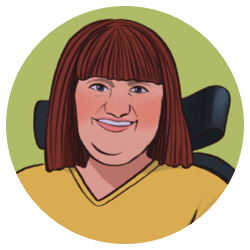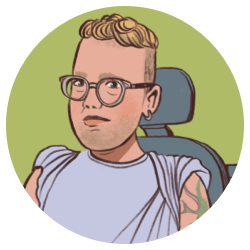SMA Treatment Advancements
We asked our team of advocates: What have advancements in treatment for spinal muscular atrophy meant to you?

Treatment is a celebration of life
Allie: The celebration of life. I have watched my disease take away so many I grew up with around me and I knew my time was coming, too.
But, with treatments that halt progression, I know that I will be here a lot longer than expected. I can also plan a future and have security knowing that I will not lose any function other than what normal old age would take from me.
I look forward to my gray hair and wrinkles, something I never imagined I would be able to have before treatment.

Advancements bring a new spark of hope
Samantha: Advancements in treatment have given me a new spark of hope. I grew up knowing that there were no options for treatment for my particular disease.
I was always aware that money was being raised for research and scientists were working hard to find a cure for my disease when I was a child. However, I never thought I would see any progress on a treatment for my disease in my lifetime.
To actually be receiving treatment makes me feel incredibly lucky and humble. I know that many individuals with rare diseases dream about that opportunity. It is something I will never take for granted.

Treatment changes can be bittersweet
Michaela: When I was diagnosed with SMA, my whole family gave blood which formed part of the studies to understand SMA. So for us as a whole family, it has meant the world to know we have played a very small part in bringing that to fruition.
I lost my sister Martina, who had SMA, and I know that many others will feel bittersweet about the developments in treatment too.
But for me, as someone lucky enough to be on treatment, I have experienced a lot of gains personally. My treatment center has monitored a number of measurements, including Quality of Life scores and motor function scores.
All of my numbers were up at least 10% at my 6-month review. It has renewed my hope for growing old, and still being a little rascal! So it means more than I can even describe.

Stopping progression of SMA
Chaz: The increase of SMA-specific treatments brings a lot of hope to me personally and to the community. And the fact that we’re seeing so many in recent years is encouraging that more treatments could be on the horizon.
Selfishly I get a little jealous watching videos of SMA babies running around and never experiencing a symptom, and maybe that means one day spinal muscular atrophy will be in medical history books.
For me, though, new treatments are all about stopping progression when my whole life I had to fear I’d be getting a little bit worse each day.

Treatment would be a life-changer
Ainaa: I still haven't had the chance to get treatment in my country.
If I’m able to receive the treatment, it will be a life-changer for me. SMA is a progressive disease. I can feel that my muscles have become weaker. My body used to be stronger, but it has become weak and requires more assistance when moving.
It’s frustrating sometimes. I feel I need to cut my time for work and rest more. I want to gain strength back throughout my body. I would love to be active and try more things in life.
To hear that there is treatment available seems like there is hope. I do wish before I close my eyes I would be able to receive it. Not just for me but everyone else. No matter what type of SMA or what age we are.

Hope for a cure
Mike: Hope. I have lived my life always holding on to hope.
I have been going to a neurologist for almost 40 years. I have had quite a few over those years, some better than others. One common assurance I have received from them is that they believed they would see a cure in their lifetime.
Now I know no one can really make that guarantee. However, that has given me hope that it can happen. When I was first diagnosed many years ago, there were no treatments. Today we have FDA-approved treatments for SMA. There are currently other treatments in the pipeline being researched. All of those treatments represent hope.

Join the conversation